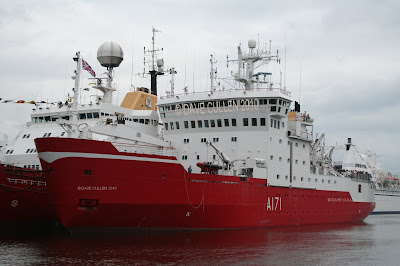HMS Endurance is the Royal Navy's Antarctic ice patrol ship. She is a class 1A1 icebreaker, with pennant number A171.
HMS Endurance was built over a period in Norway in 1990 by Ulstein Hatlo for Rieber Shipping as MV Polar Circle. The Navy chartered her for eight months as HMS Polar Circle from 21 November 1991. She was bought outright and renamed HMS Endurance on 9 October 1992.
Endurance provides a sovereign presence in polar waters, performs hydrographic surveys and supports the British Antarctic Survey in Antarctica. Her usual deployment has seen her in the South Atlantic and returning to the UK through tropical waters each year. More recently a longer, 18-month deployment was designed to maximise her time available for BAS usage.
In 1997, she made the first visit to Buenos Aires after the Falklands War and returned in 2002.
In 2005, Endurance was chosen to carry HM The Queen and HRH The Duke of Edinburgh at the International Fleet Review as part of the Trafalgar 200 celebrations.
During survey work in Antarctica in January 2006, the ship's engineering staff discovered her rudder was loose on the stock. Her work period was cut short and she returned to Mare Harbour in the Falkland IslandsDet Norske Veritas, the ship's assurance certification company instructed that the ship should dock at the nearest available port - the nearest big enough being Puerto Belgrano, Argentina's largest naval base, where Endurance docked in mid-March 2006. Without hotel services on board, the ship's company moved to shore-side accommodation in the city of Bahía Blanca, some twenty kilometres west of Puerto Belgrano. The rudder was removed for repairs and once on the floor of the drydock, a dockers' strike followed. The ship remained there for nearly three weeks. Picket lines formed at the gates of the naval base, preventing Endurance's crew from relieving the stranded duty watch on board. When the strike broke, the rudder was replaced and welded into position and the ship left Puerto Belgrano in early April 2006. She returned to Portsmouth via Lisbon and to drydock again for further engineering work on the rudder and stock. for further inspections.
In July 2007 the United Kingdom offered HMS Endurance to supply Argentine Antarctic bases after their ARA Almirante Irizar icebreaker suffered extensive damage in a fire.
In December 2008, while on an 18-month deployment, Endurance suffered extensive lower deck flooding resulting in the near loss of the ship.
A serious engine room flood left her without power or propulsion,
and she was towed to Punta Arenas by a Chilean tug. After an extensive survey was completed, the estimates to refit the ship are put at around £25million.
On 8 April 2009 Endurance arrived off Portsmouth, on the semi-submersible transporter ship MV Target.
The Royal Navy inquiry found that the flood happened when a valve opened because air lines (which had been extremely poorly installed making reconnection ambiguous and which fell below generally accepted standards for pipe intallation) had been incorrectly reconnected during unnecessary onboard maintenance. Due to manpower constraints the ship did not have a System Maintainer. Clarity of engineering command had been lost and no-one was clearly in charge of risk-management. It was fortunate that after the propulsion stopped due to the flooding, Endurance drifted over an area shallow enough for anchors to hold and stabilise her, otherwise Endurance would probably have been lost by flooding or running ashore. The ship’s company responded well to control damage in challenging conditions.
In 2009, National Geographic Channel ran a four-episode documentary series on HMS Endurance. Five ran the same series the following year, with the final episode showing what happened the day ship almost sank.
As of May 2010 Endurance remains in Portsmouth with repair work yet to start, prompting press speculation she will be scrapped as a result of the forthcoming Strategic Defence Review.
According to a Freedom Of Information Request submitted in June 2010 regarding the status of Endurance, the Ministry Of Defence currently do not know what will happen to her but a decision will be made in the first part of 2011 at the latest.
She is seen here in Leith with the BASV James Clark Ross berhted on her inside.
This is her Lynx helicopter showing off























































